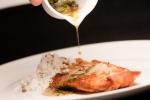Dover Sole Meunière with Transglutaminase

Recipe
Photos
- Dirk Flanigan, Pastry Chef Carly Sullivan, and Sommelier Shebnem Ince at Henri

- Chef Dirk Flanigan of The Gage - Chicago, IL

- Executive Chef Dirk Flanigan, Sommelier Shebnem Ince and Pastry Chef Carly Sullivan of Henri and The Gage - Chicago, IL

- James Beard Dinner with Chicago Chef Dirk Flanigan of The Gage and Henri – New York, NY

- The StarChefs.com 15th Anniversary Afterparty Hosted by Dirk Flanigan and The Gage - Chicago, IL

“One of the things we do at Henri,” says Chicago Chef Dirk Flanigan, “is take classics and revamp them.” In this case, it’s the classically French—and performance-heavy—Sole Meunière, given the chem-class treatment at Henri with a little meat glue, a.k.a. transglutaminase, and a vacuum seal. Before memories of kindergarten come flooding back, we should note Flanigan isn’t slathering Elmer’s between Dover sole fillets; he’s fusing a modern culinary perspective with a protein-restructuring technique common in Japan, where popular, supermarket ready “boneless fish” are filleted, boned, “glued,” and frozen for mass market consumption.
The secret ingredient, meat glue, is actually Activa TG-RM, manufactured in Chicago (meaning it’s locally sourced for Flanigan!) by Ajinomoto Food Ingredients. With the help of a little refrigeration, transglutaminase allows chefs to bond or manipulate proteins into new textures and shapes; chefs can stack meat and fish for a surf-and-turf fillet, for example, or overhaul a single protein. There are even a few meat glue varieties for all your protein-bonding needs: Activa TG-FP for “restructuring meat and poultry,” Activa TG-TI to improve “the texture of foods containing protein naturally,” and, of course, Active TG-RM, which “restructures muscle foods,” like seafood.
But even if meat glue’s primary R&D purposes were commercial—it’s what makes “chicken” into McNuggets—it segued easily into cross-pollination-happy modern gastronomy. Heston Blumenthal is credited with introducing the enzyme to haute cuisine at The Fat Duck, and Wylie Dufresne brought meat glue’s protein-transforming powers stateside with shrimp noodles at wd~50. Flanigan, who’s as happy preparing upscale gastropub fare as he in the vernacular of modern fine dining, uses meat glue to avoid the anachronistic (and bulky) tradition of tableside deboning and sautéing for his Sole Meunière. Just a sprinkling of Activa and Flanigan can prepare an elegant, tender, contemporary Dover Sole Meunière entirely in the back of house—satisfying tableside thrill-seekers with a service-time, personalized pour of brown butter with capers, lemon, and parsley.
Not only does this preparation mean fewer waiters planted tableside for the better part of a half hour, it’s safer. “It’s a small dining room,” Flanigan says of Henri. “It’s difficult for people to be maneuvering around with a knife.”
Dover Sole Meunière
Step 1: Beginning with a very sharp knife inserted just behind the head, fillet the Dover Sole, careful to avoid wasting any flesh.
Step 3: Sprinkle the sides of each fillet with Activa TG-RM and press them together gently so the Activa-sprinkled sides are touching.
Step 4: Put the sandwiched fillets—as many as three or four across—into a vacuum bag and seal to 95 percent.
Step 5: Let the fish sit for six hours to tighten the bond. Treat fish as you would a whole fillet.











